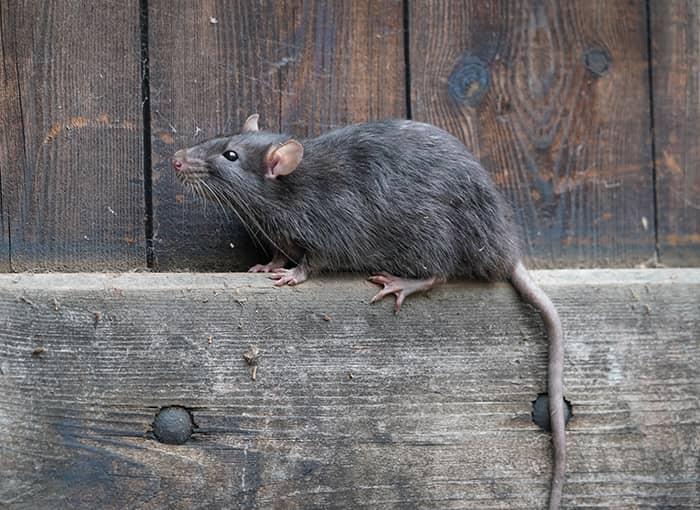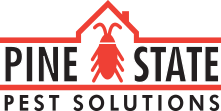What do Norway rats look like?
Norway rats, also commonly referred to as brown rats and sewer rats, have shaggy brown or gray fur, bulging eyes, blunt noses, and close-set ears. From the tips of their noses to the end of their bald tails Norway rats measure approximately 16 inches and may weigh over a pound.

Where do Norway rats nest?
Outside Norway rats are typically found living and nesting in fields, along riverbanks, in garbage piles and wood piles, and underneath of concrete slabs. When these rats infest homes and other buildings they are often found nesting in basements, crawl spaces, and behind the walls of ground floors. Although they are not as good at climbing as roof rats are, they may infest attics and upper levels of buildings.
Do Norway rats hibernate?
No, Norway rats do not hibernate but are active all year-round. Like mice that also do not hibernate, Norway rats survive by seeking shelter indoors during the colder months.
What do Norway rats eat?
Norway rats are opportunistic omnivores that enjoy a diet of grains, fruits, meats, and various human foods.
Are Norway rats dangerous?
While Norway rats are not typically aggressive towards humans, they should be considered dangerous because they can carry and transmit diseases and parasites directly and indirectly. Exposure or contact with rat droppings, urine, and saliva can lead to Leptospirosis, hantavirus, rate-bite fever, and salmonellosis. Norway rats may introduce fleas, ticks and mites as well.
Are Norway rats destructive?
Yes, Norway rats can be quite destructive and infestations can lead to extensive damage to structures and belongings. Like other rodents, Norway rats have front incisors that continuously grow. In order to prevent overgrowth, they gnaw constantly. In homes or businesses, they often chew on wires, pipes, drywall, insulation, and other building materials as well as furniture, clothing, fabrics, books, and other personal belongings.
Norway rats also contaminate spaces with their feces and urine and their nesting and burrowing habits can lead to issues with foundations and slabs.
How fast do Norway rats reproduce?
Unfortunately, quite fast! Just one female Norway rat can have several litters each year, with multiple pups per litter. What's more, they will reproduce indoors which allows them to establish large populations quickly.
Can I get rid of Norway rats on my own?
While there are DIY rodent control methods available for purchase, professional pest control is more effective. That's because traps and baits you buy at the store or online only address the rodents searching for food and shelter and doesn't take into consideration how rats are getting inside, what's attracting them in the first place, or how quickly they're reproducing. Without accurate identification and a thorough assessment of the problem, you won't have much luck getting rid of Norway rats on your own.
How do you get rid of Norway rats?
Norway rats are difficult to exterminate in homes and businesses without the help of professional rodent control specialists. DIY rat control is ineffective because it typically does not address the root cause of the infestation.
At Pine State Pest Solutions, we offer effective rodent control and management plans for both residential and commercial environments in Saco, Portland, and Brunswick as well as throughout our multi-county service area.
Bundle your rodent control with home pest control for ultimate pest protection
For homeowners who find themselves battling rats and mice as well as other nuisance and potentially destructive pests common to our region, Pine State Pest Solutions offers comprehensive home pest control services that target both rodents and insects.
Starting as low as $35/month*

Pine State’s Home Protection is an affordable pest control plan that is ideal for homeowners who want general pest control services that target common house-infesting insects and rodents.
When you sign up for this ongoing service, you’ll receive an initial service visit to treat the existing pest problem and then seasonal service visits spread out over the year to ensure pests stay out. That’s a total of four services annually.
Pests covered under Pine State’s Home Protection plan include carpenter ants, cornfield ants, crazy ants, field ants, little black ants, pavement ants, Asian lady beetles, carpet beetles, cigarette beetles, drugstore beetles, flour beetles, ground beetles, hide beetles, larder beetles, saw-toothed grain beetles, warehouse beetles, boxelder bugs, carpenter bees, centipedes, clover mites, American cockroaches, brown-banded cockroaches, wood cockroaches, field crickets, house crickets, European earwigs, firebrats, cluster flies, fruit flies, bald-faced hornets, European hornets, deer mice, house mice, millipedes, Angoumois grain moths, drain moths, Indian meal moths, Mediterranean flour moths, mud daubers, Norway rats, paper wasps, pill bugs, rice weevils, silverfish, sow bugs, springtails, cellar spiders, daddy longlegs spiders, house spiders, jumping spiders, sac spiders, wolf spiders, Western conifer seed bugs, and yellow jackets.
*Some exclusions apply- please see your agreement
Norway rat prevention tips
Listed below are some helpful tips from our local Maine pest control experts to help prevent Norway rats from becoming a problem in and around your property.
- Do not store firewood inside or right against the side of the house.
- Seal any opening on the exterior of the structure. This is also commonly referred to as building them out.
- Implement a good housekeeping plan.
- Organize storage areas to eliminate potential harborages.
- Remove potential food sources like overflowing garbage cans and pet food left outside.
- Use durable outdoor trash cans and make sure the covers fit. Do not overfill.
